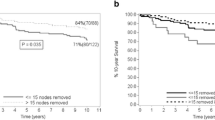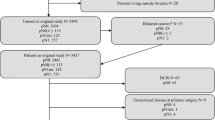Abstract
A population-based study was performed to assess the likelihood of axillary lymph node metastases in patients with clinically negative lymph nodes, according to patient age, tumor size and site, estrogen receptor status, histologic type and mode of detection. Data were obtained from the population-based Eindhoven Cancer Registry. During the period 1984–1997, 7680 patients with invasive breast cancer were documented, 6663 of whom underwent axillary dissection. Of the 5125 patients who were known to have clinically negative lymph nodes and underwent axillary dissection, 1748 (34%) had positive lymph nodes at pathological examination. After multivariate analysis, histologic type, tumor size, tumor site and the number of lymph nodes in the axillary specimen remained as independent predictors of the risk of nodal involvement (P < 0.001). Lower risks were found for patients with medullary or tubular carcinoma, smaller tumors, a tumor in the medial part of the breast and patients with less than 16 nodes examined. This study gives reliable estimates of the risk of finding positive lymph nodes in patients with a clinically negative axilla. Such information is useful when considering the need for axillary dissection and to predict the risk of a false-negative result when performing sentinel lymph nodebiopsy.
Similar content being viewed by others
References
Tabar L, Fagerberg G, Chen HH, Duffy SW, Smart CR, Gad A, Smith RA: Efficacy of breast cancer screening by age. New results from the Swedish Two-County Trial. Cancer 75: 2507–2517, 1995
Pezner RD, Patterson MP, Hill LR, Lipsett JA, Desai KR, Vora N, Wong JY, Luk KH: Arm lymphedema in patients treated conservatively for breast cancer: relationship to patient age and axillary node dissection technique. Int J Radiat Oncol Biol Phys 12: 2079–2083, 1986
Ivens D, Hoe AL, Podd TJ, Hamilton CR, Taylor I, Royle GT: Assessment of morbidity from complete axillary dissection. Cancer 66: 136–138, 1992
Liljegren G, Holmberg L, and The Uppsala-Örebro Breast Cancer Study Group: Arm morbidity after sector resection and axillary dissection with or without postoperative radiotherapy in breast cancer stage I. Results from a randomised trial. Eur J Cancer 33: 193–199, 1997
Lin PP, Allison DC, Wainstock J, Miller KD, Dooley WC, Friedman N, Baker RR: Impact of axillary lymph node dissection on the therapy of breast cancer patients. J Clin Oncol 11: 1536–1544, 1993
Hack TF, Cohen L, Katz J, Robson LS, Goss P: Physical and psychological morbidity after axillary lymph node dissection for breast cancer. J Clin Oncol 17: 143–149, 1999
Giuliano AE, Dale PS, Turner RR, Morton DL, Evans SW, Krane DL: Improved axillary staging of breast cancer with sentinel lymphadenectomy. Ann Surg 222: 394–401, 1995
Roumen RMH, Valkenburg JGM, Geuskens LM: Lymphoscintigraphy and feasibility of sentinel node biopsy in 83 patients with primary breast cancer. Eur J Surg Oncol 23: 495–502, 1997
Veronesi U, Paganelli G, Galimberti V, Viale G, Zurrida S, Bedoni M, Costa A, de Cicco, Geraghty JG, Luini A, Sacchini V, Veronesi P: Sentinel-node biopsy to avoid axillary dissection in breast cancer with clinically negative lymph-nodes. Lancet 349: 1864–1867, 1997
Veronesi U, Paganelli G, Viale G, Galimberti V, Luini A, Zurrida S, Robertson C, Sacchini V, Veronesi P, Orvieto E, De Cicco C, Intra M, Tosi G, Scarpa DI: Sentinel lymph node biopsy and axillary dissection in breast cancer: results in a large series. J Natl Cancer Inst 91: 368–373, 1999
Ahlgren J, Stål O, Westman G, Arnesson L-G and the South-East Sweden Breast Cancer Group: Prediction of axillary lymph node metastases in a screened breast cancer population. Acta Oncol 33: 603–608, 1994
Barth A, Craig PH, Silverstein MJ: Predictors of axillary lymph node metastases in patients with T1 breast cancer. Cancer 79: 1918–1922, 1997
Chada M, Chabon AB, Friedmann P, Vikram B: Predictors of axillary lymph node metastases in patients with T1 breast cancer. Cancer 73: 350–353, 1994
Gann PH, Colilla SA, Gapstur SM, Winchester DJ, Winchester DP: Factors associated with axillary lymph node metastasis from breast carcinoma. Descriptive and predictive analyses. Cancer 86: 1511–1519, 1999
Olivotto IA, Jackson JSH, Mates D, Andersen S, Davidson W, Bryce CJ, Ragaz J: Prediction of axillary lymph node involvement of women with invasive breast carcinoma. A multivariate analysis. Cancer 83: 948–955, 1998
Ravdin PM, De Laurentiis M, Vendely T, Clark GM: Prediction of axillary lymph node status in breast cancer patients by use of prognostic indicators. J Natl Cancer Inst 86:1771–1775, 1994
Shetty MR, Reiman HM: Tumor size and axillary metastases, a correlative occurrence in 1244 cases of breast cancer between 1980 and 1995. Eur J Surg Oncol 23: 139–141, 1997
Silverstein MJ, Gierson ED, Waisman JR, Senofsky GM, Colburn WJ, Gamagami P: Axillary lymph node dissection for T1a breast carcinoma. Is it indicated? Cancer 73: 664–647, 1994
Axelsson CK, Mouridsen HT, Zedeler K: Axillary dissection of level I and II lymph nodes is important in breast cancer classification. The Danish Breast Cancer Cooperative Group (DBCG). Eur J Cancer 28A: 1415–1418, 1992
Holmberg L, Lindgren A, Nordén T, Adami HO, Bergström R: Age as a determinant of axillary node involvement in invasive breast cancer. Acta Oncol 31: 533–538, 1992
Mustafa IA, Cole B, Wanebo HJ, Bland KI, Chang HR: The impact of histopathology on nodal metastases in minimal breast cancer. Arch Surg 132: 384–391, 1997
Mathiesen O, Carl J, Bonderup O, Panduro J: Axillary sampling and the risk of erroneous staging of breast cancer. An analysis of 960 consecutive patients. Acta Oncol 29: 721–725, 1990
Kiricuta CI, Tausch J, Math D: A mathematical model of axillary lymph node involvement based on 1446 complete axillary dissections in patients with breast carcinoma. Cancer 69: 2496–2501, 1992
Port ER, Tan LK, Borgen PI, Van Zee KJ: Incidence of axillary lymph node metastases in T1a and T1b breast carcinoma. Ann Surg Oncol 5: 23–27, 1998
Rageth JC, Wyss P, Unger C, Haller U: Axillary lymphadenectomy. Just how radical should it be? Surg Oncol 1: 37–41, 1996
Reynolds JV, Mercer P, McDermott EWM, Cross S, Stokes M, Murphy D, O'Higgins NJ: Audit of complete axillary dissection in early breast cancer. Eur J Cancer 30A: 148, 149, 1994
Haffty BG, McKhann C, Beinfield M, Fischer D, Fischer JJ: Breast conservation therapy without axillary dissection. Arch Surg 128: 1315–1319, 1993
Kuznetsova M, Graybill JC, Zusag TW, Hartsell WF, Griem KL: Omission of axillary lymph node dissection in early stage breast cancer: effect on treatment outcome. Radiology 197: 507–510, 1995
AI-Hilaly M, Willsher PC, Robertson JFR, Blamey RW: Audit of a conservative management policy of the axilla in elderly patients with operable breast cancer. Eur J Surg Oncol 23: 339–340, 1997
Martelli G, De Palo G, Rossi N, Coradini D, Boracchi P, Galante E, Vertrella G: Long-term follow-up of elderly patients with operable breast cancer treated with surgery without axillary dissection plus adjuvant tamoxifen. Br J Cancer 72: 1251–1255, 1995
Sun A, Liu F-F, Pintilie M, Rawlings G: Outcome in breast cancer managed without an initial axillary lymph node dissection. Radiother Oncol 48: 191–196, 1998
Wazer OE, Erban JK, Robert NJ, Smith TJ, Marchant DJ, Schmid C, DiPetrillo T, Schmidt-Ullrich R: Breast conservation in elderly women for clinically negative axillary nodes without axillary dissection. Cancer 74: 878–883, 1994
Fossel ET, Brodsky G, deLayre JL, Wilson RE: Nuclear magnetic resonance for the differentiation of benign and malignant breast tissues and axillary lymph nodes. Ann Surg 198: 541–545, 1983
Adler LP, Faulhaber PF, Schnur KC, AI-Kasi NL, Smenk RR: Axillary lymph node metastases: screening with [F-18]2-deoxy-2-fluoro-D-glucose (FDG) PET. Radiology 203: 323–327, 1997
Sounding Board: Sentinel-lymph-node biopsy for breast cancer. Not yet the standard of care. N Engl J Med 339: 990–995, 1998
Ruers TJM, Roumen RMH: Sentinel node biopsy in patients with breast cancer: recommendations from the integral cancer centres for the introduction of this technique. Ned Tijdschr Geneeskd 142: 2237–2240, 1998
Rights and permissions
About this article
Cite this article
Voogd, A.C., Coebergh, JW.W., Driel, O.J.R.v. et al. The risk of nodal metastases in breast cancer patients with clinically negative lymph nodes: a population-based analysis. Breast Cancer Res Treat 62, 63–69 (2000). https://doi.org/10.1023/A:1006447825160
Issue Date:
DOI: https://doi.org/10.1023/A:1006447825160




